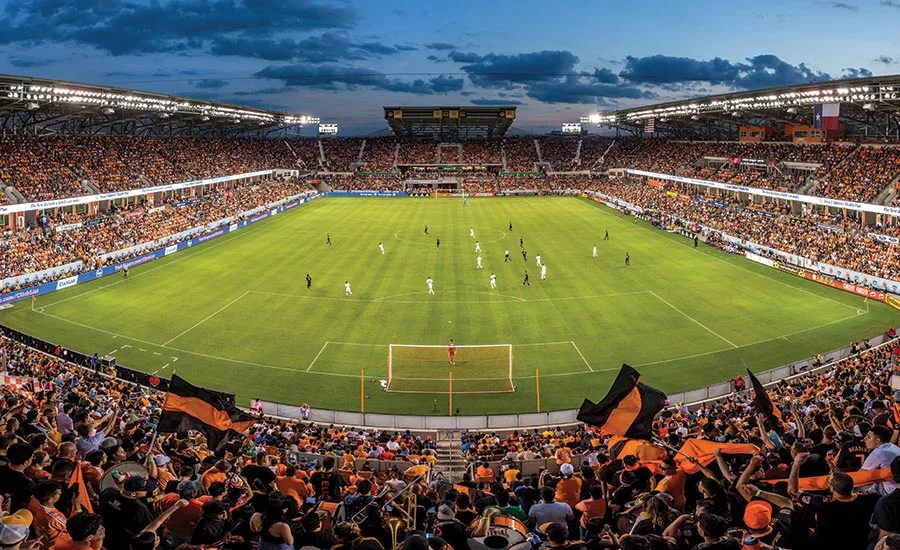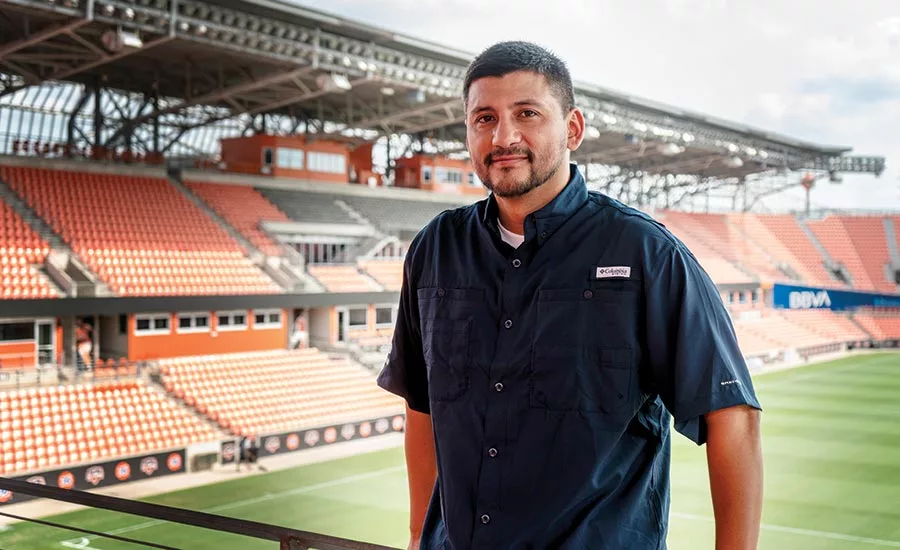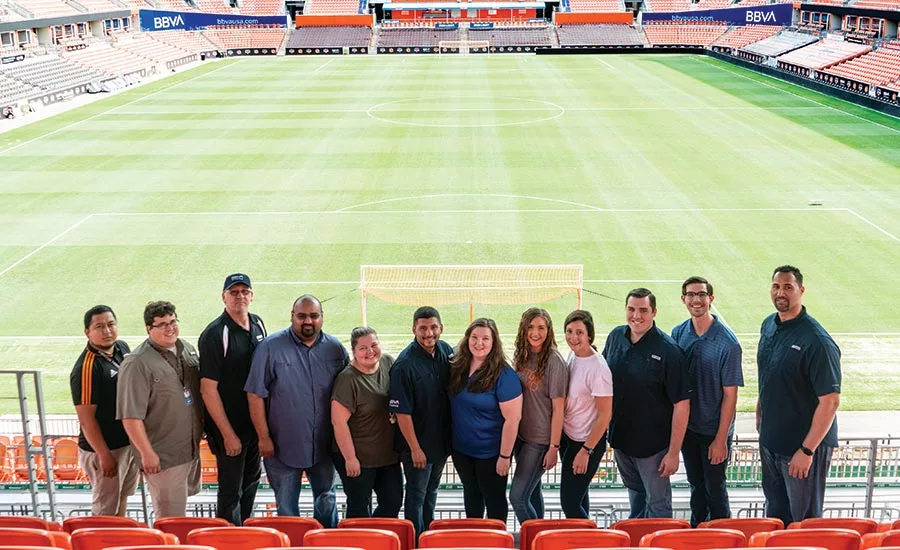GOAL!!!
Securing the Houston Dynamo Soccer Stadium
BBVA Stadium, home to the Houston Dynamo soccer team, is an epicenter of security technology and MLS soccer pride.

The intimate setting of the BBVA Stadium makes it unique among Houston sports stadiums. Combine those factors with the passion of Houston soccer fans and the “forever orange” colors of the Dynamo, and game day at BBVA Stadium is like no other.
Photo courtesy of Houston Dynamo.

Marlon Gonzalez
Photo courtesy of Houston Dynamo.

"From the time the fans leave their home, to the route they take to get to the stadium, during the game, and after the game to head home, we have programmed it," says Marlon Gonzalez, Director of Security and Transportation for Houston Dynamo, shown here with members of the BBVA Stadium Operations team.
Photo courtesy of Houston Dynamo.

The Dynamo soccer club moved to Houston from San Jose in December 2005 and played their first season in Houston in 2006. The club won consecutive MLS Cup championships in 2006-2007 and the Lamar Hunt U.S. Open Cup in 2018.
Photos courtesy of Houston Dynamo.
“There is not a bad seat in this stadium,” says Marlon Gonzalez, on a quiet, yet hot morning in June in Houston, Tex.
It is true: the design of the BBVA Stadium in Houston allows fans to feel like they are part of the action, thanks to the close proximity of all seating areas to the pitch.
At the time of this interview, the stadium was empty, but on game days, it is filled with up to 22,000 Houston Dynamo soccer fans, who love their team and the game.
Gonzalez, who is the Houston Dynamo Director of Security and Transportation, has spent much of his career working in sports security. After his military career, Gonzalez worked in security for CSC Corporation for a number of sports stadiums, including the Lincoln Financial Field and Oracle Arena. He was in Minneapolis to stand up the new U.S. Bank Stadium, home of the Minnesota Vikings, and then served as chief of public safety for SMG for the Mercedes-Benz Superdome, Smoothie King Center and Champions Square. He moved to Houston last fall to take on the role with the Dynamo.
“I love the crowd and the excitement of the game,” Gonzalez says. “For me, there’s nothing like being able to provide a positive fan experience. From the time our fans leave their home, to the route they take to get to the stadium, during the game, and after the game to head home, we have programmed it. We are in control of all aspects inside the stadium in addition to the parking lots and the street routes that our fans take to get home. I want our fans to have a good time and know that I played a huge role in that.”
The Houston Dynamo franchise competes in Major League Soccer (MLS), as a member of the Western Conference. The Dynamo first played their home games at Robertson Stadium on the University of Houston campus until 2011. Since 2012, the Dynamo have played home matches at BBVA Stadium. The Dynamo is owned by Gabriel Brener, Jake Silverstein, and Ben Guill, along with Olympic gold medalist and world champion boxer Oscar De La Hoya.
The stadium was designed by Populous, the architecture firm behind new Yankee Stadium in New York. The design echoes both the rich industrial heritage of the urban East Downtown site of Houston and the Dynamo’s aspirations to be an elite brand in North American soccer.
The stadium is located closer to downtown than any other American MLS stadium. It is situated on a six-block urban site near Minute Maid Park (home of the Houston Astros), the George R. Brown Convention Center and the Toyota Center (home of the Houston Rockets). The stadium’s distinctive façade features Dynamo orange coloring along with a geometrically-shaped tessellated aluminum mesh that encompasses the stadium while also providing air circulation throughout the facility.
Inside the stadium is a wide concourse for fans to access a lower and an upper seating section. It’s also used for shelter- in-place situations like lightning strikes or other weather emergencies. There are 33 suites, three party suites, president club seating and 160 field level seats. There are six entrances for employees, VIP guests, fans and the media.
Security and Safety
It’s easy to forget that more than 20 years ago MLS was a new, 10-team league. Over the last decade, MLS has grown at an average pace of just about a team a year: 11 MLS expansion teams in just 10 years (2007-2017). In the near future, the league plans to have 28 teams, with 12 cities competing for the last four spots.
As the league grows, so does the need to standardize many aspects of stadium security and safety. “Right now, it’s up to each individual stadium to decide some of those specific aspects,” Gonzalez says. “For example, some stadiums will allow their ultra-fans to light flares and set off smoke bombs after a goal is scored. That is beyond my comfort level. Here, we hire a pyrotechnic company to not only set off the smoke bombs, but to secure the area and clean it up. Some stadiums do not require magnetometer at stadium entrances, but we have always employed them. We do allow fans to bring in bags, but they have to be a certain size. And we are exploring a clear bag policy for the future.”
Gonzalez has an advanced security technology solution in place. There are 56 IP security video surveillance cameras mounted inside and outside of the stadium, all of which feed into a command post. The outside cameras tie into the city of Houston police department and provide Gonzalez information on the parking lot, pedestrian and vehicle traffic outside of the stadium and queue lines for before and after the games. There are three cameras that feed video directly to the MLS League offices in New York to monitor the field of play, in addition to ensuring game presentation aspects. A VMS provides video analytics to help stadium security and operations to identify and mitigate any issues and communicate information to the 160 to 200 security team on game day, which also includes a team of Harris County Sherriff Officers.
Outside of the stadium, Gonzalez is challenged with the stadium’s perimeter. “We are in the middle of a city,” he explains. “There are apartments and homes on two sides and a railway on another side. We are allowed to close down some streets, but beyond that, I am unable to extend my security perimeter.”
Inside of the stadium, in the command post, are four security holding rooms for fans who get out of control, which ranges from fighting, to throwing items on the pitch, or running on to the field. The penalty for those infractions is serious: mandatory lifetime bans, bans for one to three games, or a six- to 12-month suspension. “We have been fortunate; we are averaging less than one ejection or arrest per game this year,” Gonzalez says.
He attributes that rate in part, to de-escalation training and the Dynamo fan base and supporter groups. “My security team and I have regular training, but I’m also a strong proponent of training in other areas, such as food safety. If unsafe food comes into the stadium, for example, my staff could be impacted in some way, so I need to understand food safety. Even more, if a sales team member is threatened over the phone, I need to become involved and teach them how to de-escalate it. We also teach personal safety to our employees, as we want them to be comfortable entering and leaving the stadium.”
He strongly advocates de-escalation training for all fan-related security and safety incidents. “Nine out of 10 incidents can be de-escalated,” he says. “If you have the mentality that you are going to eject a fan from the building, then that will happen. But it does not have to end in a negative way. If you listen and empathize, then maybe they are ejected without handcuffs or without fighting with your staff. They will take their written warning or ban, leave the stadium and hopefully come back with a positive attitude.”
Fan code of conduct videos are played before the game, in addition to numerous signage that is strategically placed through the stadium and at every entrance. The signage clearly discusses which items are prohibited, in addition to information about how and when banners can be hung, flags, or no “moshing” or violent dancing.
Gonzalez has worked in stadium security for most of his career, but was surprised to learn about the intensity and loyalty of the MLS soccer fan base. “They are dedicated and passionate,” he says, of the two Dynamo supporter groups.
All around the world, supporter groups have been linked to local clubs and globally recognized clubs alike. In many cases, you will find supporter groups in one city that are for a club in another country (especially with the well-known clubs like Barcelona or Manchester United). They are highly organized and are the lifeblood of their teams and organizations.
At BBVA, the two supporter groups provide energy and support as they passionately cheer on the Dynamo team, dressing themselves in orange Dynamo apparel and showing allegiance to the team.
“We have a great relationship with our supporter groups,” Gonzalez explains. “It is a give and take situation. We meet monthly with them to discuss any security or safety issues that are taking place in the stands, in addition to concerns with fans from visiting teams. They will self-report and self-police and even remove a fan who is out of control. We count on them to help us to create an intimate setting and a good fan experience for each and every game.”
Looking for a reprint of this article?
From high-res PDFs to custom plaques, order your copy today!







